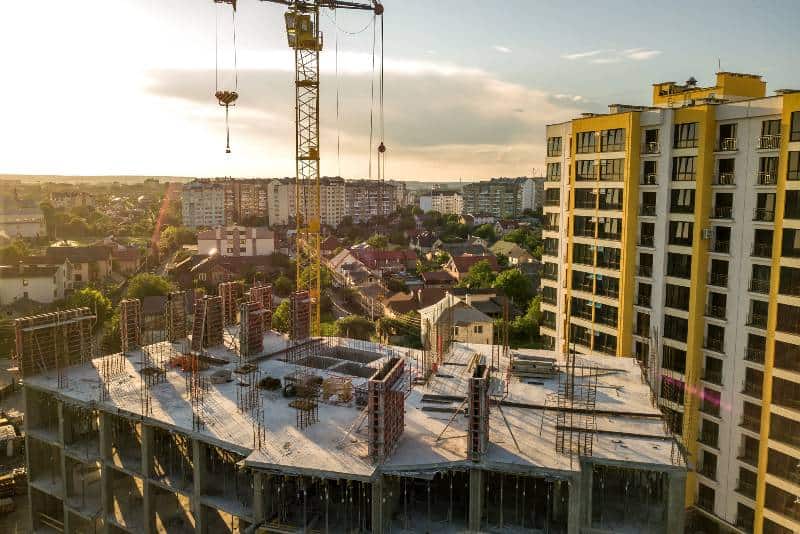Older commercial buildings lacking the necessary amenities to attract today’s workers back to the workplace might be more suitable for conversion to other purposes. Due to the pandemic, more people are working remotely, causing a decrease in demand for office spaces and lower occupancy rates.
In the third quarter of 2022, the national office vacancy rate reached a record high of 17.1%, which is the highest in almost 30 years. As a result, companies are offering up excess office space for sublease. This abundance of office space is likely to persist and have a negative impact on market conditions for some time to come.
Modern office tenants as well as central business districts have higher expectations from their buildings in terms of quality, design, location, and sustainability. They are opting for buildings that have more amenities and are reducing their overall space. Be sure to read this article talking about the power of green that’s transforming the real estate industry!
Only the nation’s office inventory consists of Class A space built since 2010, and not all of it meets quality building standards. Outdated buildings with obsolete designs and arrangements are being neglected.
What is their fate? Building owners have three options: they can keep the building as it is and reduce the rent further to attract more tenants, sell the property, possibly at a lower price compared to better-located buildings, or demolish or convert it for a different use the land or structure like an office to residential conversions.
Jessica Morin, CBRE’s America’s head of office research, reports that there are currently 125 ongoing obsolete office buildings and projects across the country. Around 30 percent of these projects involve converting offices into multifamily buildings, while 50 percent are being converted into life sciences spaces. The remaining projects are being converted into hotels or other uses.
Key Takeaways
- Assess suitability by examining the location, building structure, and local regulations to identify optimal office spaces for conversion.
- Ensure compliance with zoning laws and building codes, addressing residential use, fire safety, accessibility, and other requirements.
- Plan and budget effectively by engaging professionals, considering contingencies, and creating a realistic timeline to maximize return on investment.

Assessing Office Spaces for Conversion
Identifying suitable properties
If you are considering a move to a new home, one alternative that could be a perfect fit for you is an office-to-apartment conversion. Before making any final decisions, however, it is important to assess the office space you are considering for conversion. This means examining things like the location, size, and structure of the office building to determine if it is a viable option for an apartment.
Evaluating the Potential for rental income
It’s important to assess the space before diving into the project. Consider the layout and functionality of the current setup and brainstorm potential ways to transform it into a livable and attractive space. Once you’ve identified the changes you want to make, it’s time to evaluate the potential for rental income. Research the rental market in your area and determine what amenities and features renters are looking for. By taking the time to assess and plan ahead, you can ensure a successful and profitable office-to-apartment conversion.
Understanding zoning regulations and building codes
Understanding zoning regulations and building codes is crucial when converting office spaces to apartments, as they dictate the permissible uses of a property and set standards for safety, accessibility, and construction quality. Here are some key aspects to consider:
- Zoning regulations: Verify if the property is zoned for residential use or if rezoning is required. Zoning laws regulate land use, density, building heights, and setbacks, and may also influence parking and green space requirements.
- Building codes: Familiarize yourself with local building codes, which establish minimum standards for structural integrity, fire safety, electrical, plumbing, and mechanical systems. Codes also cover ventilation, insulation, and energy efficiency requirements.
- Accessibility: Ensure compliance with accessibility regulations, such as the Americans with Disabilities Act (ADA), which mandates accessible design features in public and common areas, as well as a percentage of accessible dwelling units.
- Fire safety: Adhere to fire safety requirements, including fire-resistant materials, sprinkler systems, fire alarms, emergency exits, and egress routes.
- Structural modifications: Consult with structural engineers to evaluate the building’s capacity to accommodate modifications, such as removing or altering walls, adding balconies, or installing new plumbing and electrical systems.
Preparing for Conversion
Creating a budget and timeline
Transforming an office space into an apartment can be an exciting and rewarding project. With proper planning and preparation, the conversion process can be smooth and efficient. Creating a budget and timeline is key to ensuring that the project stays on track and within financial constraints. Determining a realistic timeline based on the scope of the project and available resources is an important first step. Additionally, researching and hiring reputable contractors can ensure that the project is completed successfully.
Hiring architects and contractors
It’s a big project but one that can reap incredible rewards. To start, consider hiring a team of architects and contractors who specialize in apartment conversions. They’ll be able to help you work through the various hurdles that come with changing an office space into a home. From zoning issues to plumbing problems, these experts know how to tackle any challenge. Plus, they can help you create a space that is both functional and stylish, helping convert what was once a workplace into a comfortable sanctuary.
Obtaining necessary permits and approvals
Before taking any action, it is important to obtain the necessary permits and approvals to ensure a safe and legal conversion. Don’t worry, this process may seem daunting, but with the help of knowledgeable professionals, it can be completed smoothly. Preparing for the conversion can be an exciting time! You can begin by creating a solid plan that includes the layout and design of your new living space.
Designing the Apartment Space
Space planning and layout
Designing the apartment space involves careful space planning and layout to create functional and attractive living environments. Key considerations include:
- Assessing the existing structure: Evaluate the office building’s layout, available natural light, and structural elements to determine optimal apartment configurations.
- Maximizing space utilization: Create efficient floor plans that make the best use of available space, considering the target tenant demographic and market demands.
- Balancing open and private spaces: Incorporate a mix of open-concept living areas and private spaces, such as bedrooms and bathrooms, to cater to varied tenant preferences.
- Ensuring accessibility and circulation: Design layouts with clear circulation paths and accessible features, adhering to local building codes and guidelines.
- Integrating storage solutions: Provide adequate storage options within the apartments, including built-in closets, cabinets, and shelving.
- Prioritizing comfort and functionality: Consider ergonomics, lighting, ventilation, and soundproofing to ensure a comfortable living environment.
- Customizing finishes and amenities: Tailor the design elements and amenities to the target tenant market, balancing aesthetics and durability.
- Planning for communal areas and facilities: Allocate space for shared amenities such as laundry rooms, gyms, and lounges to enhance the overall living experience.
With the right design and layout, you can turn what was once a mundane workspace into a warm and inviting living area. Space planning is an important aspect of this transformation, as you’ll want to make the most of every inch of available space. A professional interior designer can help you optimize your layout while taking your personal style and needs into account. Whether you’re looking for an open floor plan, or to section off specific areas for privacy or functionality, a thoughtfully planned space is key to making your office-to-apartment conversion a success.
Selecting materials and finishes
Selecting materials and finishes for an office-to-apartment conversion is crucial for creating attractive, durable, and low-maintenance living spaces. Here are some guidelines:
- Durability: Choose materials that can withstand daily wear and tear, especially in high-traffic areas such as hallways, kitchens, and bathrooms.
- Aesthetics: Opt for finishes that complement the overall design theme, creating a cohesive and visually appealing environment.
- Maintenance: Select materials that are easy to clean and maintain, reducing the long-term upkeep costs for both landlords and tenants.
- Budget: Balance quality and cost, focusing on materials that offer the best value for money without compromising on durability or appearance.
- Sustainability: Consider eco-friendly materials and finishes, such as reclaimed wood, low-VOC paint, or energy-efficient fixtures, to minimize environmental impact and appeal to environmentally conscious tenants.
Consider converting your office into an apartment space! With the right design elements and materials, a functional workplace can seamlessly transform into a comfortable living area. When designing the space, pay attention to the layout and flow of the area, taking into account key features such as lighting and storage options. Choosing the right materials and finishes can also elevate the overall look and feel of the space. From sleek hardwood flooring to modern fixtures, selecting the right elements can make all the difference.
Incorporating sustainable and energy-efficient features
Incorporating sustainable and energy-efficient features in an office-to-apartment conversion can lower utility costs, reduce environmental impact, and appeal to eco-conscious tenants. Here are some strategies to consider:
- Insulation: Improve insulation in walls, ceilings, and windows to minimize heat transfer, reducing energy consumption for heating and cooling.
- Energy-efficient windows: Install double-glazed or low-emissivity windows to minimize heat loss in winter and heat gain in summer.
- LED lighting: Use energy-efficient LED lighting fixtures, and incorporate natural light with strategically placed windows, skylights, or light wells.
- Energy-efficient appliances: Equip apartments with Energy Star-rated appliances, such as refrigerators, dishwashers, and washing machines, to reduce energy consumption.
- HVAC systems: Install energy-efficient heating, ventilation, and air conditioning systems, and consider incorporating smart thermostats for optimal temperature control.
Incorporating sustainable and energy and cost-efficient features into the design can not only reduce your carbon footprint but also help you save on utility costs. From choosing the right insulation to selecting appliances with high energy ratings, there are many ways to make your new apartment more eco-friendly.
Managing the Conversion Process
Overseeing construction and renovation work
Overseeing construction and renovation work during an office-to-apartment conversion is essential to ensure a successful project outcome. Here are some steps to follow:
- Hire professionals: Engage experienced architects, engineers, and contractors to manage the project and ensure quality workmanship.
- Obtain permits: Secure all necessary permits and approvals from local authorities, including building permits, zoning changes, and any required inspections.
- Develop a detailed timeline: Create a comprehensive schedule, outlining project milestones and deadlines to keep the construction on track and avoid delays.
- Establish a clear communication plan: Facilitate regular communication between all parties involved, including status updates, progress meetings, and prompt resolution of any issues that arise.
- Monitor the budget: Track expenses closely, compare them to the initial budget, and adjust as needed to avoid cost overruns.
If you’re considering turning office space into an apartment, it’s important to have a solid plan in place before beginning the conversion process. Hiring an experienced contractor or project manager can make all the difference in ensuring that the renovation runs smoothly from start to finish. From obtaining necessary permits to overseeing construction work, a skilled professional can take care of the logistics so that you can focus on creating your dream apartment. With a clear timeline and a detailed budget in place, your office-to-apartment transformation can be a success.
Addressing challenges and setbacks
Converting an office space into an apartment can be a daunting process, but with proper management and planning, it can lead to a beautiful and functional living space. One of the biggest challenges in this process is addressing unforeseen setbacks that may arise. These challenges can range from structural issues to unexpected costs. However, by working closely with professionals and being open to creative solutions, these setbacks can be overcome.
Ensuring safety and compliance
Converting an office to an apartment may seem like a daunting task, but with the right management, it can be a smooth and rewarding process. The key is to ensure safety and compliance throughout the entirety of the conversion process. This involves obtaining necessary permits, conducting thorough inspections, and adhering to building codes and regulations. By partnering with experienced professionals who understand the intricacies of office conversions, you can rest assured that the project will move forward in a safe and efficient manner.
Marketing and Renting the New Apartments
Highlighting the unique features of converted spaces
When marketing and renting new apartments, it’s important to highlight the unique features of the converted space. Highlighting the historic charm, sleek design, or convenient location can attract potential tenants. Presenting an inclusive and community-based message in your tone of voice is important too. Professional, friendly, and informative messaging can help build a trustful relationship with potential renters.
Setting competitive rental rates
Transforming an office into an apartment is an exciting project for landlords, but the conversion isn’t complete until there are tenants waiting to move in. To market these new residential units effectively, it’s important to set competitive rental rates that will entice potential renters. Landlords should establish themselves as approachable and professional resources for interested parties, outlining all the benefits of the new apartments in a friendly and informative tone of voice. In order to find the perfect tenants for these unique living spaces, it’s essential to put in the time and effort to create a robust marketing plan tailored to target the right audience.
Attracting and retaining tenants
Converting office spaces into apartments can be a lucrative investment for landlords, but the key to success is attracting and retaining tenants. To ensure a successful venture, it’s important to develop a marketing strategy that targets the right audience and highlights the unique features of the newly converted apartments. Professional photos and virtual tours can also help showcase the space and amenities. Once tenants are in place, it’s essential to build strong relationships by providing excellent customer service, responding promptly to maintenance requests, and offering incentives to renew leases
Office to Apartment Conversion FAQs
Why should landlords consider converting offices to apartments?
Due to the increase in remote work and the decrease in demand for office space, landlords should think about converting their office spaces into apartments. This conversion could lead to optimized property usage, increased rental income, and a wider pool of potential tenants. Furthermore, repurposing office buildings could improve urban revitalization and promote sustainable development by repurposing existing structures.
How can landlords identify suitable office spaces for conversion?
To find office spaces that can be converted into suitable living spaces, landlords should consider factors such as location, building structure, and local regulations. An ideal option would be a well-located building with an adaptable layout, enough natural light, and appropriate ceiling height. It’s important to research zoning laws and building codes to make sure the conversion is feasible and doesn’t lead to legal problems. Speaking with architects or real estate professionals can also provide helpful guidance.
What are the zoning and building code considerations for conversions?
To convert a property, you need to ensure that it is zoned for residential use and meets building code standards. This includes addressing fire safety, accessibility, and structural integrity. You should also comply with requirements for parking, green space, and soundproofing to avoid legal issues.
How should landlords budget and plan for an office-to-apartment conversion?
Planning and budgeting for an office-to-apartment conversion can be a daunting task, but with the right guidance and tools, the process can be seamless. Start by evaluating the scope of the project and determine the necessary modifications and permits needed for a successful conversion. Consider working with a reputable contractor who specializes in office-to-apartment conversions and can assist in creating a realistic budget for the project.
What professionals should landlords hire for a successful conversion?
Converting an office space into an apartment takes a team effort, and developers and landlords need to know which professionals to hire for a successful conversion. Firstly, contractors who understand zoning laws and building codes will ensure that the apartment is safe and habitable. Secondly, interior designers and architects can help transform the space into a welcoming living area complete with a functional layout, good lighting, and proper storage options.
Is smart move safe?
Converting outdated office buildings into apartments can be a smart, profitable move if properly executed. Key factors are realistic costs, zoning laws, neighborhood demand dynamics, innovative design, and adequate financing. However, plentiful risks exist, so conduct thorough due diligence before proceeding.
Conclusion
converting an office space into an apartment is an intriguing and potentially lucrative endeavor. It requires research to select the right building, thoughtful planning to budget and timetable the project, and taking into account any local zoning or building regulations to ensure compliance. There are various benefits included in this venture, such as improved aesthetics of local neighborhoods, the heightened property value of the area, and increased access to affordable housing.
To make sure your project meets all legal requirements while enabling you to maximize your return on investment, it is critical that you work with experienced professionals and stay flexible with contingencies every step of the way. If you are contemplating office-to-apartment conversion for your next project and have any questions, don’t hesitate to reach out – I offer free consultations here at Toljcommercial!
Blog Articles Disclaimer
The information presented in articles on our website or affiliated platforms is exclusively intended for informational purposes. It’s crucial to grasp that this content does not constitute professional advice or services. We strongly recommend our readers to seek guidance from appropriately qualified experts, including, but not limited to, real estate and other attorneys, accountants, financial planners, bankers, mortgage professionals, architects, government officials, engineers, and related professionals. These experts can offer personalized counsel tailored to the specific nuances of your individual circumstances. Relying on the content without consulting the relevant experts may hinder informed decision-making. Consequently, neither Tolj Commercial Real Estate nor its agents assume any responsibility for potential consequences that may arise from such action.






